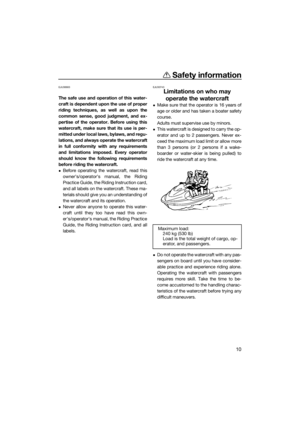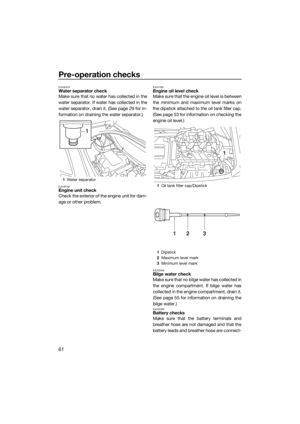Page 25 of 110

Safety information
18
erŌĆÖs or water-skierŌĆÖs ability, as well as water
and weather conditions.
’ü¼When preparing to pull a wakeboarder or
water-skier, operate the watercraft at the
slowest possible speed until the watercraft
is well away from the person being pulled
and slack in the ski rope is taken up. Make
sure that the rope is not looped around
anything.
After checking that the wakeboarder or wa-
ter-skier is ready and that there is no traffic
or other obstacles, apply enough throttle to
raise the person.
’ü¼Make smooth, wide turns. The watercraft is
capable of very sharp turns, which could
exceed the abilities of the wakeboarder or
water-skier. Keep the person being towed
at least 50 m (164 ft), about twice the dis-
tance of a standard ski rope, away from
any potential hazard.
’ü¼The operators of boats and other water-
craft may not be aware that you are pulling
a wakeboarder or water-skier. Together
with the spotter, pay attention to others
around you and cruise at safe speeds.
’ü¼Be alert to the hazard of the ski rope handle
snapping back at the watercraft when the
wakeboarder or water-skier falls or is un-
able to get up.
’ü¼Towing heavy or bulky objects other than
wakeboarders or water-skiers, such as an-
other boat or watercraft, can cause loss of
steering control and create a hazardous
condition. If you must tow another boat in
an emergency situation, operate slowly
and cautiously.
EJU30971
Safe boating rules
Your Yamaha watercraft is legally considered
a powerboat. Operation of the watercraft
must be in accordance with the rules and
regulations governing the waterway on which
it is used.
UF4G74E0.book Page 18 Tuesday, July 16, 2019 10:27 AM
Page 26 of 110

Safety information
19
EJU30992
Enjoy your watercraft
responsibly
You share the areas you enjoy when riding
your watercraft with others and with nature.
So your enjoyment includes a responsibility
to treat these other people, and the lands,
waters, and wildlife with respect and courte-
sy.
Whenever and wherever you ride, think of
yourself as the guest of those around you.
Remember, for example, that the sound of
your watercraft may be music to you, but it
could be just noise to others. And the exciting
splash of your wake can make waves others
wonŌĆÖt enjoy.
Avoid riding close to shoreline homes and
waterfowl nesting areas or other wildlife ar-
eas, and keep a respectful distance from fish-
ermen, other boats, swimmers, and
populated beaches. When travel in areas like
these is unavoidable, ride slowly and obey all
laws.
Proper maintenance is necessary to ensure
that the exhaust emission and sound levels of
your watercraft will continue to be within reg-
ulated limits. You have the responsibility to
make sure that the recommended mainte-
nance in this ownerŌĆÖs/operatorŌĆÖs manual is
carried out.
Remember, pollution can be harmful to the
environment. Do not refuel or add oil where a
spill could cause damage to nature. Remove
your watercraft from the water and move it
away from the shoreline before refueling. Dis-
pose of water and any fuel and oil residue in
the engine compartment according to local
regulations. And keep your surroundings
pleasant for the people and wildlife that share
the waterways: donŌĆÖt litter.When you ride responsibly, with respect and
courtesy for others, you help ensure that our
waterways stay open for the enjoyment of a
variety of recreational opportunities.
UF4G74E0.book Page 19 Tuesday, July 16, 2019 10:27 AM
Page 27 of 110

Description
20
EJU43331
Watercraft glossary
Trolling speed
ŌĆ£TrollingŌĆØ is the lowest maneuvering speed. You are applying little or no throttle. The water-
craft is down in the water, and there is no wake.
Sub-planing speed
ŌĆ£Sub-planingŌĆØ is a medium speed. The bow of the watercraft is slightly up from the water sur-
face, but you are still traveling through the water. There is a wake.
Planing speed
ŌĆ£PlaningŌĆØ is a faster speed. The watercraft is more level and is skimming on top of the water.
There is a wake.
Bow
The front end of the watercraft.
Stern
The rear end of the watercraft.
Starboard
The right side of the watercraft when facing forward.
Port
The left side of the watercraft when facing forward.
Bilge water
Water that has collected in the engine compartment.
Yamaha Engine Management System (YEMS)
YEMS is an integrated, computerized management system that controls and adjusts ignition
timing, fuel injection, engine diagnostics, and the off-throttle steering (OTS) system.
Reverse with Intuitive Deceleration Electronics (RiDE)
RiDE is an electronic system that controls the reverse, neutral, and deceleration operations of
the watercraft.
UF4G74E0.book Page 20 Tuesday, July 16, 2019 10:27 AM
Page 28 of 110
Description
21
EJU31012
Location of main components
Exterior
1
11
2
345
6
7
8
9
107
1Hood
2Fuel filler cap (page 50)
3Handlebar
4Front seat (page 43)
5Rear seat (page 43)
6Footwell
7Pull-up cleat (VX Limited) (page 46)
8Sponson
9Gunwale
10Cooling water pilot outlet (page 29)
11Bow eye (page 45)
UF4G74E0.book Page 21 Tuesday, July 16, 2019 10:27 AM
Page 29 of 110
Description
22
1
10
1145678954
2
3
1Boarding platform
2Cleat (page 45)
3Handgrip (page 44)
4Stern eye (page 45)
5Stern drain plug (page 55)
6Reverse gate (VX / VX Deluxe / VX Cruiser /
VX Limited) (page 31)
7Jet thrust nozzle
8Ride plate
9Reboarding step (VX / VX Deluxe /
VX Cruiser / VX Limited) (page 44)
10Speed sensor
11Intake grate
UF4G74E0.book Page 22 Tuesday, July 16, 2019 10:27 AM
Page 30 of 110
Description
23
65 12 34 9 11
10 12 9
7 8
15
1413
1RiDE lever (VX / VX Deluxe / VX Cruiser /
VX Limited) (page 31)
2Start switch (page 27)
3Engine shut-off switch (page 27)
4Clip (page 27)
5Glove compartment (page 47)
6Remote control transmitter (VX Deluxe /
VX Cruiser / VX Limited) (page 25)
7Engine shut-off cord (lanyard) (page 27)
8Engine stop switch (page 27)
9Rearview mirror (VX / VX Deluxe /
VX Cruiser / VX Limited)
10Cruise assist up switch (VX Deluxe /
VX Cruiser / VX Limited) (page 36)
11Multifunction information center (page 38)
12Throttle lever (page 28)
13ŌĆ£SETŌĆØ switch (VX Deluxe / VX Cruiser / VX
Limited) (page 36)
14Cruise assist down switch (VX Deluxe /
VX Cruiser / VX Limited) (page 36)15ŌĆ£NO-WAKE MODEŌĆØ switch (VX Deluxe /
VX Cruiser / VX Limited) (page 34)
UF4G74E0.book Page 23 Tuesday, July 16, 2019 10:27 AM
Page 31 of 110
Description
24
Engine compartment
1
6
7
10 2
345
89
1Fuse box
2Air filter case
3Spark plug/Ignition coil
4Oil tank
5Removable watertight storage compart-
ment (page 48)
6Water separator (page 29)
7Fuel tank
8Flushing hose connector (page 81)
9Oil tank filler cap/Dipstick (page 53)
10Battery (page 61)
UF4G74E0.book Page 24 Tuesday, July 16, 2019 10:27 AM
Page 32 of 110

Control function operation
25
EJU31026
Watercraft control functionsEJU43690Remote control transmitter
(VX Deluxe / VX Cruiser / VX Limited)
The Yamaha Security System and Low RPM
Mode settings can be selected by operating
the remote control transmitter. (See page 26
for Yamaha Security System setting proce-
dures and page 33 for Low RPM Mode acti-
vation procedures.)
Since the watercraft is programmed to rec-
ognize the internal code from this transmitter
only, the settings can only be selected with
this transmitter.
If you accidentally lose your remote control
transmitter or if it is not operating properly,
contact a Yamaha dealer.
When operating the watercraft, always keep
the transmitter with you, such as by storing itin the transmitter holder in the glove compart-
ment, so that it is not lost.
NOTICE
ECJ00753
’ü¼The remote control transmitter is not
completely waterproof. Do not sub-
merge the transmitter or operate it un-
derwater. If the transmitter is
submerged, dry it with a soft, dry cloth,
and then check that it is operating prop-
erly. If the transmitter is not operating
properly, contact a Yamaha dealer.
’ü¼Keep the remote control transmitter
away from high temperatures and do
not place it in direct sunlight.
’ü¼Do not drop the remote control trans-
mitter, subject it to strong shocks, or
place any heavy items on it.
’ü¼Use a soft, dry cloth to clean the remote
control transmitter. Do not use deter-
gent, alcohol, or other chemicals.
’ü¼Do not attempt to disassemble the re-
mote control transmitter yourself. Oth-
erwise, the transmitter may not operate
properly. If the transmitter needs a new
battery, contact a Yamaha dealer. Refer
to local hazardous waste regulations
when disposing of transmitter batteries.
1Remote control transmitter
1Transmitter holder
1
UF4G74E0.book Page 25 Tuesday, July 16, 2019 10:27 AM
 1
1 2
2 3
3 4
4 5
5 6
6 7
7 8
8 9
9 10
10 11
11 12
12 13
13 14
14 15
15 16
16 17
17 18
18 19
19 20
20 21
21 22
22 23
23 24
24 25
25 26
26 27
27 28
28 29
29 30
30 31
31 32
32 33
33 34
34 35
35 36
36 37
37 38
38 39
39 40
40 41
41 42
42 43
43 44
44 45
45 46
46 47
47 48
48 49
49 50
50 51
51 52
52 53
53 54
54 55
55 56
56 57
57 58
58 59
59 60
60 61
61 62
62 63
63 64
64 65
65 66
66 67
67 68
68 69
69 70
70 71
71 72
72 73
73 74
74 75
75 76
76 77
77 78
78 79
79 80
80 81
81 82
82 83
83 84
84 85
85 86
86 87
87 88
88 89
89 90
90 91
91 92
92 93
93 94
94 95
95 96
96 97
97 98
98 99
99 100
100 101
101 102
102 103
103 104
104 105
105 106
106 107
107 108
108 109
109






